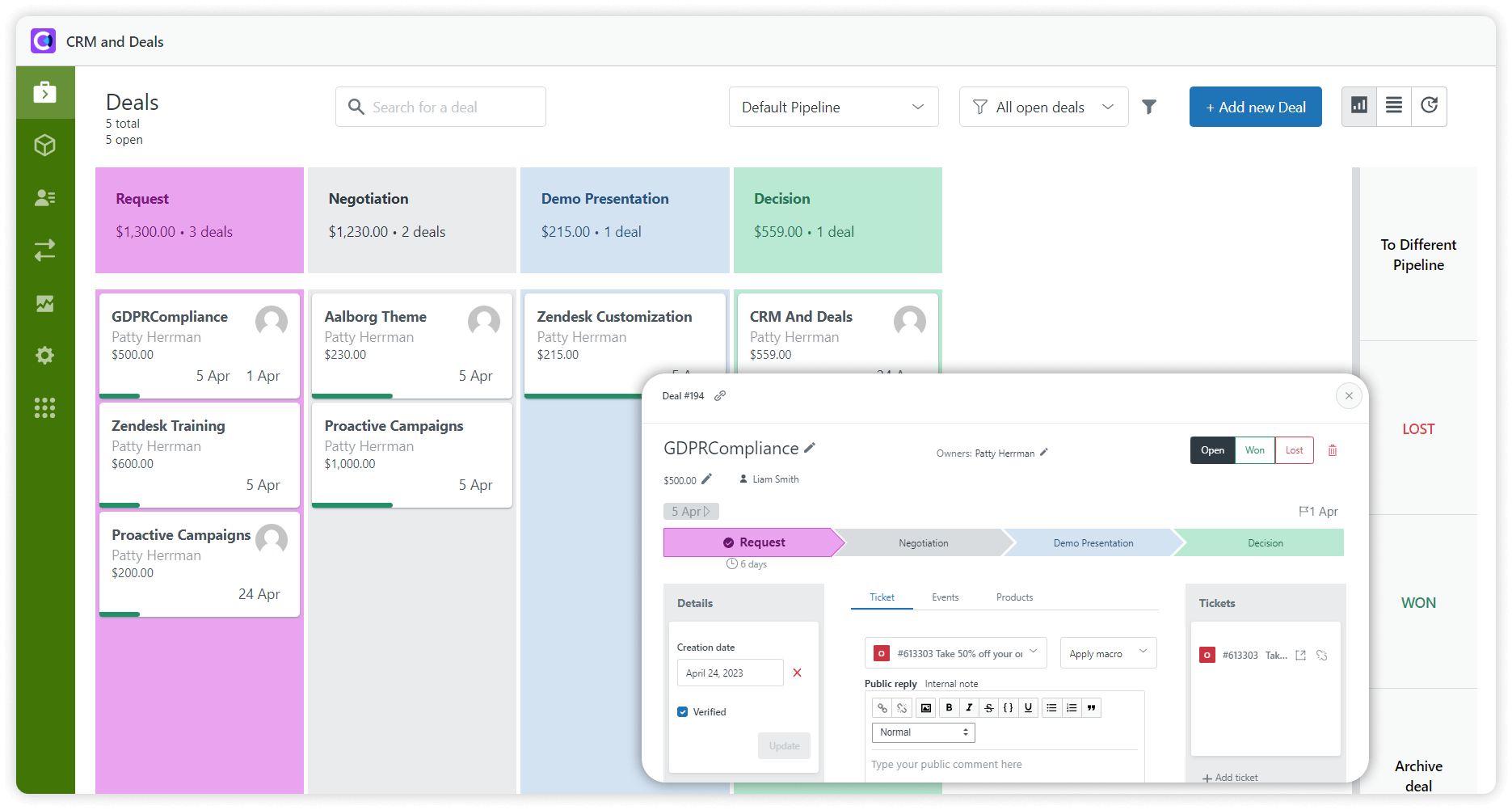Today, more than ever before, understanding and managing your sales pipeline is the cornerstone of success.
In our comprehensive guide, we will delve into what is a pipeline in business and explore the nuances of sales pipeline management. Additionally, we'll offer insights and strategies to optimize your sales process and drive business growth.
Just read on.
What is a Sales Pipeline?
Let’s start with a definition and pipeline meaning in business.
To put it simply, a healthy sales pipeline is essentially the backbone of a sales team's strategy, as well as a dynamic visual representation of where potential customers are within the standardized sales process.
It also meticulously outlines the journey through the sales funnel, from initial contact through to the final sale, defining each step along the way: lead generation, qualification, proposal, negotiation, and closure.
This pipeline serves as a strategic roadmap, guiding sales reps on how to move prospects through these stages toward becoming paying customers effectively.
Overall, it’s not just a tool for tracking; rather, it's a strategic asset that helps in planning and forecasting, providing a structured overview of ongoing and potential sales opportunities.
The key metrics associated with the sales pipeline, such as its average size, the length of the sales cycle, and the conversion rate, are invaluable for sales teams. They offer insights into the health and potential of the sales efforts, enabling teams to gauge their current performance accurately and forecast future sales with a higher degree of confidence. Understanding these metrics allows for the identification of trends, the allocation of resources where they are most needed, and the implementation of targeted strategies to nurture and close deals more effectively.
What is Pipeline Management?

What is pipeline management?
Sales pipeline management goes beyond merely understanding what the pipeline is. It involves a meticulous process of tracking and managing every sales opportunity from inception to close.
Then, how to manage your sales pipeline?
The comprehensive management encompasses each stage of the sales process, ensuring that leads are not just entered into the system but are actively moved towards the goal of closing. The effective pipeline management process is characterized by a deep understanding of the pipeline's architecture, vigilant monitoring of sales activities, and the strategic use of key performance metrics to inform decisions and strategies.
The essence of this process lies in its ability to show areas of inefficiency, identify bottlenecks that may be slowing down the sales process, and pinpoint opportunities for optimization.
Through diligent management, sales teams can ensure that their efforts are not only consistent but also aligned with broader business objectives, thereby maximizing efficiency, improving conversion rates, and ultimately, boosting overall revenue.
It’s a dynamic process that requires constant attention and adaptation as sales managers and their teams assess the pipeline's performance, implement adjustments, and strive for continual improvement in both strategy and execution. By focusing on effective pipeline management, businesses can enhance their sales operations, leading to sustainable growth and success.
Why is Sales Pipeline Management Important?
The strategic significance of the sales pipeline in business and the framework of a company's sales operations and overall business strategy is profound. It acts as the pivotal structure supporting effective sales methodologies and future business scalability.
Impact on Sales Performance
The influence of robust sales pipeline management and implementation of sales pipeline management best practices on sales performance is multifaceted.
By implementing an effective pipeline management system and strategies, sales teams can better prioritize their outreach and engagement efforts, focusing their energy on leads and opportunities that present the highest value.
Furthermore, a well-orchestrated sales pipeline strategy allows for a more streamlined sales process, potentially reducing the sales cycle duration. This efficiency not only benefits the sales team by freeing up time to pursue additional opportunities but also improves the customer's experience by providing timely and relevant interactions.
Enhanced productivity, stemming from effective pipeline management, leads to an increase in sales opportunities and a higher probability of closing deals, thereby directly boosting sales outcomes and revenue generation.
Connection to Business Growth
The health of a sales pipeline serves as a barometer for the future growth potential of a business. Besides, a pipeline brimming with high-quality prospects that are systematically and efficiently converted into paying customers is indicative of a robust sales operation poised for expansion. This consistent flow is vital for ensuring a stable and predictable revenue stream, which is essential for long-term business sustainability and growth.
Moreover, sales pipeline management yields critical insights into prevailing market trends, evolving customer preferences, and the resonance of sales strategies with the target audience. Such insights are invaluable for strategic planning, allowing businesses to adapt and refine their sales approaches in alignment with market dynamics and customer expectations.
By leveraging the intelligence gathered from pipeline analysis, companies can make informed decisions that not only cater to immediate sales objectives but also align with broader business growth ambitions. This strategic alignment ensures that sales efforts are effective in the short term and contribute to the company's long-term vision and growth trajectory.
Key Elements of a Successful Sales Pipeline
Navigating through the complexities of a sales pipeline and transforming leads into customers is an intricate process that hinges on several pivotal elements.
Understanding and optimizing these elements, such as lead generation and qualification, sales stages and progression, and the closing of deals, are fundamental in crafting a sales strategy that not only enhances efficiency but also significantly boosts outcomes.
Lead Generation and Qualification
The bedrock of any thriving sales pipeline is the ability to generate and then qualify leads effectively. This stage is all about casting a wide net to identify potential customers and then meticulously sifting through these prospects to pinpoint those with the highest likelihood of conversion. Effective lead generation hinges on understanding where potential customers gather, what messages resonate with them, and how best to reach them.
Once leads are in the pipeline, the qualification process becomes critical. It’s about scrutinizing each lead against a set of predefined criteria to ensure they have a genuine need for the product or service, the authority to make purchasing decisions, and the budget to afford it.
This rigorous process ensures that sales efforts are concentrated on leads who are interested, capable, and ready to buy, thereby maximizing the efficiency of the sales process.
Sales Stages and Progression

For a sales pipeline to function effectively, a clear understanding and definition of the sales stages are paramount. Each stage of the sales process marks a critical juncture in the journey of a lead becoming a customer. Managing it demands not only a clear set of criteria for advancing leads from one stage to the next but also a keen insight into the nuances of each step.
Sales teams must be adept at navigating these stages, employing strategies tailored to the unique needs and concerns of the lead at each point. This level of strategic oversight ensures that the pipeline remains fluid, with leads moving steadily towards conversion, and allows sales teams to identify and address any potential stalls or bottlenecks in the process.
Closing Deals and Conversion Rates
The culmination of the sales pipeline process is the closing of deals that requires a delicate balance of persuasion, negotiation, and relationship-building.
Achieving a high conversion rate, where a significant portion of leads turn into sales, is the ultimate testament to the effectiveness of the sales pipeline and the strategies employed throughout the sales process.
This stage is where all the groundwork laid during lead generation, qualification, and progression pays off. It involves understanding the lead’s needs and concerns, presenting solutions in a compelling manner, and negotiating terms that are agreeable to both parties.
Monitoring and analyzing conversion rates at each stage of the pipeline not only provides insight into the health and efficiency of the sales process but also highlights areas where improvements can be made.
Strategies for Effective Sales Pipeline Management
Implementing robust strategies for managing a sales pipeline is essential for any business aiming to improve its closing rates and foster sustainable growth. Let’s discuss some of the pipeline management best practices.
Strategies for Cultivating Leads
Cultivating leads effectively is a nuanced process that demands personalized communication and deep engagement with potential customers. It starts with a thorough understanding of each lead's unique needs and preferences, which allows for tailored interactions that provide real value.
This personalized approach should be consistent across all touchpoints, from email communications to social media interactions, ensuring that every engagement helps to build trust and credibility with the lead.
Employing interactive content, such as webinars, e-books, and customized demos, can further enrich the lead experience, making each interaction memorable and informative.
The goal is to create a positive, seamless journey that not only moves leads closer to conversion but also fosters a sense of loyalty and advocacy, laying the groundwork for long-term relationships and repeat business.
CRM Systems and Automation
The complexity of pipeline sales management requires the use of advanced tools and technologies, with CRM systems and automation standing out as key tools for reaching efficiency.
A CRM system, especially one designed for sales pipeline management like CRM and Deals for Zendesk, acts as the central hub for all sales-related activities. It streamlines the tracking of lead interactions, sales progress, and customer data, thereby enhancing the visibility and management of the sales pipeline.

The integration of automation tools further augments this process by taking over repetitive tasks, such as data entry and lead scoring, freeing up sales teams to focus on strategy and direct sales efforts.
The automation of routine processes boosts productivity and ensures a higher degree of accuracy in data management, enabling sales teams to make more informed decisions based on reliable data.
Sales Forecasting and Predictive Analysis
Forecasting and predictive analysis are indispensable for effective sales pipeline management, providing the insights needed for strategic planning and resource allocation.
By analyzing historical sales data and identifying trends, sales managers can forecast future performance with a higher level of accuracy. This predictive capability allows for the setting of realistic sales targets and the efficient distribution of resources across the sales team.
Moreover, predictive analysis can help identify potential market shifts and customer behavior changes, enabling proactive adjustments to sales strategies.
How to Calculate Sales Pipeline Velocity

Understanding and calculating sales pipeline velocity is crucial for businesses aiming to optimize their sales process and accelerate revenue growth. This metric provides a clear snapshot of how swiftly leads are progressing through the sales pipeline and transforming into profitable deals.
To calculate sales velocity, you start by multiplying the number of deals currently in your pipeline by the average deal size and the overall conversion rate.
This product gives you an aggregate value representing the potential revenue flowing through your pipeline. Then, dividing this figure by the average length of your sales cycle (in days or stages) yields the velocity — essentially, how quickly a lead turns into revenue.
The sales pipeline velocity serves as a critical indicator of the health and efficiency of your sales operations. A higher velocity signifies a streamlined, effective sales process where leads are quickly converted, indicating robust sales health. Conversely, a slow velocity may highlight bottlenecks or inefficiencies needing attention, such as prolonged negotiation phases or ineffective lead qualification.
Examples and Case Studies
Let’s look at some of the examples of successful sales pipeline management from well-known companies.
Successful Implementations of Sales Pipeline Management
HubSpot
A prime example of effective sales pipeline management is HubSpot, a leading CRM, marketing, sales, and service software provider. HubSpot successfully implemented an "inbound marketing" strategy that closely aligns sales and marketing teams' efforts. This alignment ensures a seamless transition of leads from marketing campaigns to sales, optimizing the sales pipeline's efficiency.
By using its own tools to nurture leads with personalized content and score them based on engagement, HubSpot has demonstrated how a well-managed sales pipeline can lead to increased conversion rates and customer retention.
Salesforce
Salesforce, the global giant in CRM solutions, showcases the power of using its platform to manage its sales pipeline. By leveraging advanced analytics and artificial intelligence features within Salesforce CRM, the company has optimized lead scoring and prioritization, ensuring sales teams focus their efforts on the most promising opportunities.
This strategic use of technology has shortened the sales cycle and also improved the accuracy of sales forecasting.
Lessons Learned from Notable Cases
Zappos
While not a typical example of sales pipeline management, Zappos' emphasis on customer experience offers valuable lessons. The company's dedication to customer satisfaction has led to high levels of customer loyalty and repeat business, underscoring the importance of nurturing relationships even after a sale is closed. They have proved that managing a sales pipeline is not just about converting leads into customers but also about maintaining those relationships for future sales opportunities.
Xerox
Xerox, facing declining sales, implemented a comprehensive training program for its sales force, focusing on improving sales skills and knowledge of customer needs. This initiative led to a revitalized sales pipeline with better-qualified leads and more effective sales strategies. The key lesson from Xerox's experience is the importance of investing in sales team performance and development to enhance the overall performance of the sales pipeline.
Conclusion
Sales pipeline management stands as a pivotal component in the machinery of successful sales operations. Through careful planning, strategic implementation, and continuous optimization, businesses can significantly enhance their sales performance and drive growth.
The journey from understanding what a sales pipeline is to effectively managing and optimizing it involves a deep dive into lead generation, sales processes, and the utilization of CRM systems, all aimed at improving conversion rates and shortening sales cycles.
FAQs
Who is responsible for the sales pipeline?
The responsibility for managing the sales pipeline primarily lies with the sales team, with crucial oversight from sales managers. However, it's essentially a team effort that spans across departments, incorporating marketing for lead generation and customer service for maintaining satisfaction. Effective pipeline management demands cooperation and alignment among various teams to ensure a smooth transition from generating leads to closing deals.
How to build a sales pipeline?
To construct a sales pipeline, start by identifying your target market to pinpoint potential customers. Then, generate leads through targeted marketing efforts and qualify these leads to confirm they match your ideal customer profile. Engage these qualified leads with personalized communication and nurture them toward a sale.
What is the KPI in the sales pipeline?
Key Performance Indicators (KPIs) in the sales pipeline are crucial metrics that gauge the sales process's effectiveness and efficiency. Common KPIs include the average response time; conversion rate, which is the percentage of leads that become sales; the average deal size, or the average value of closed sales; the sales cycle length, which is the average duration to close a deal, and pipeline velocity, measuring the speed at which leads convert into revenue.
How can I improve my sales pipeline?
Improving your sales pipeline involves enhancing lead quality by refining your lead generation and qualification processes. Increase engagement with leads through personalized communication and nurturing tactics. Streamline the sales process by identifying and eliminating bottlenecks. Utilize CRM tools to improve pipeline visibility and management. Regularly train your sales team to refine their sales techniques and product knowledge. Continuously review and analyze pipeline sales metrics to pinpoint areas for improvement and adjust strategies as needed.







